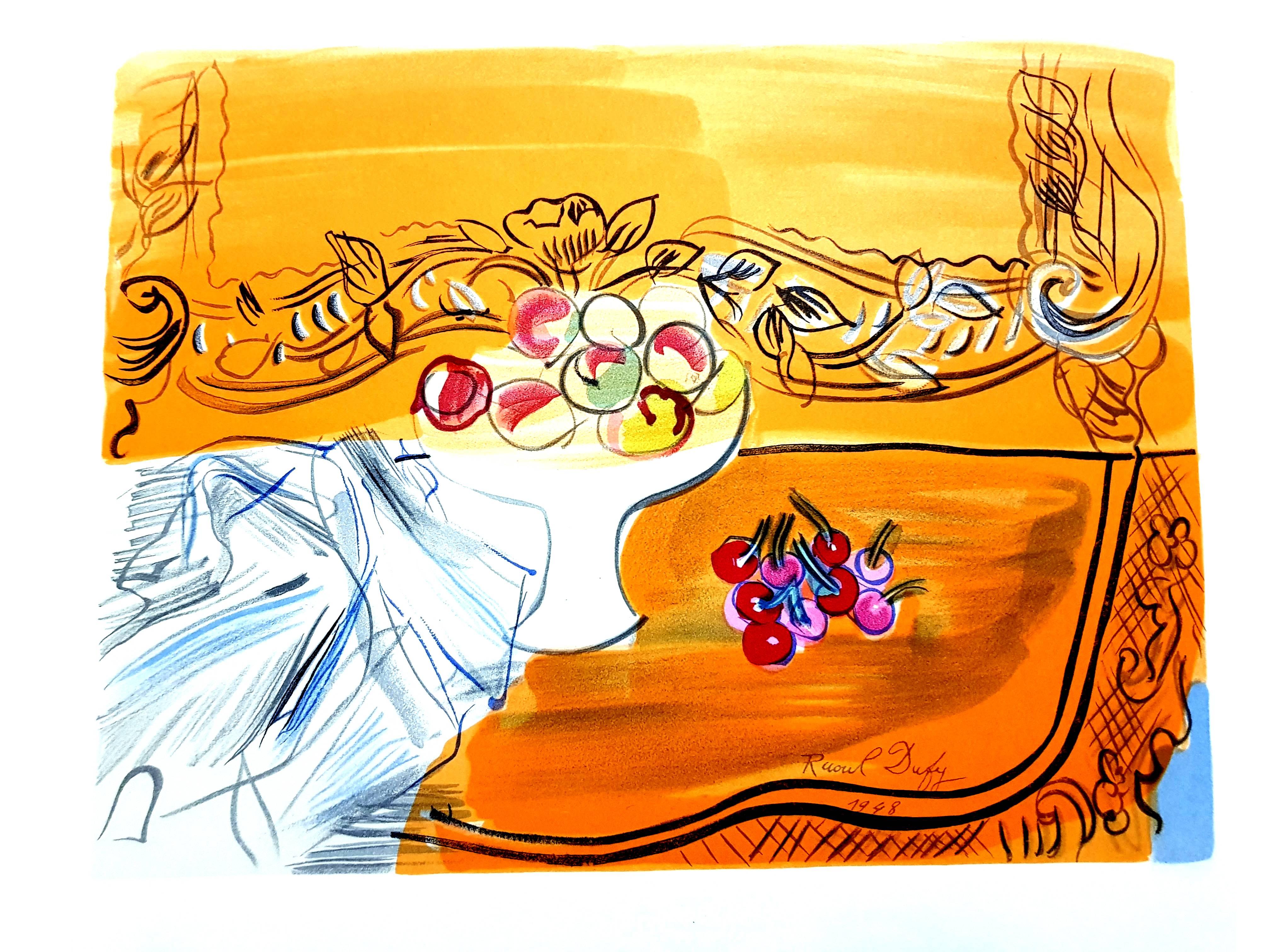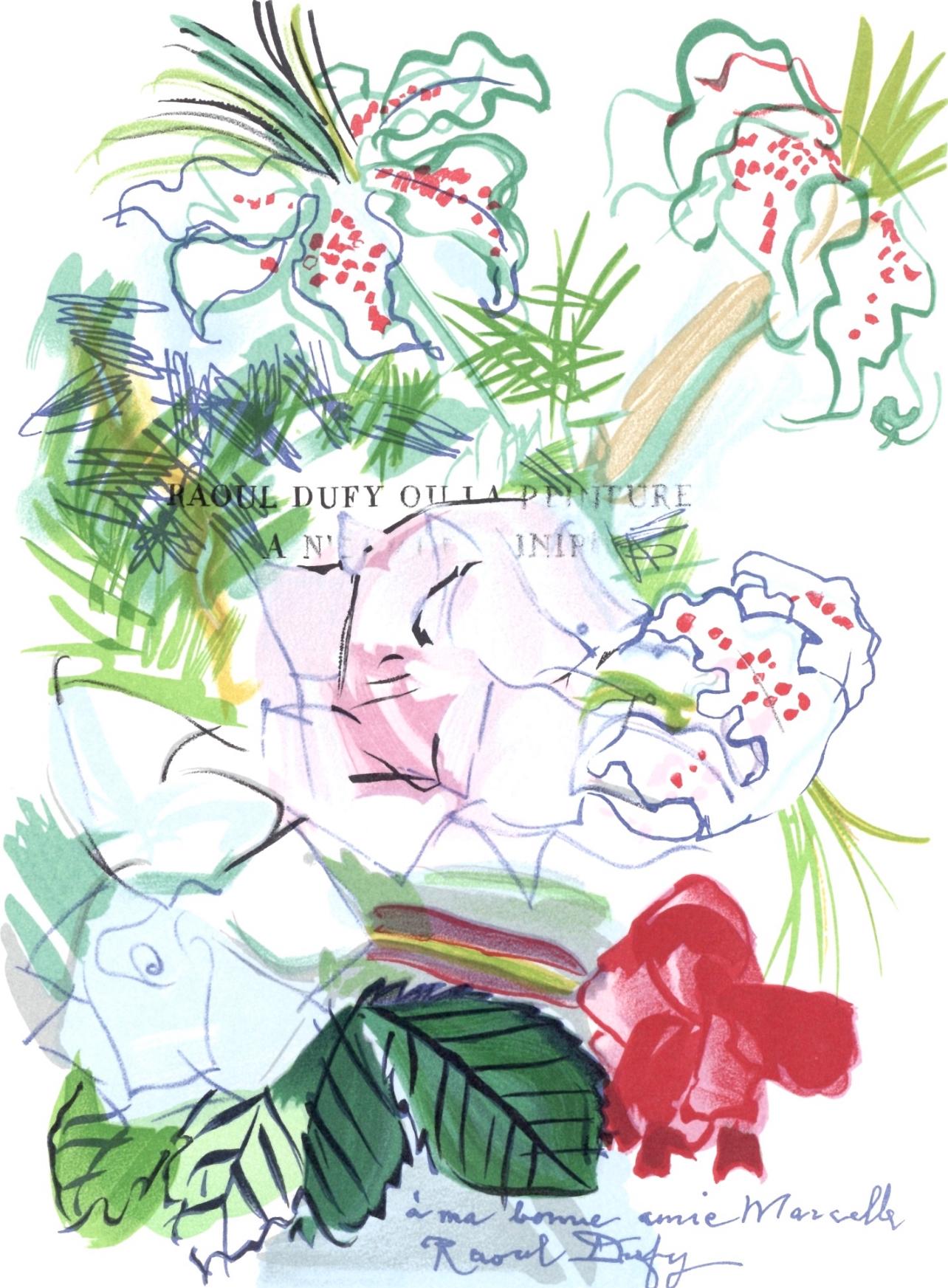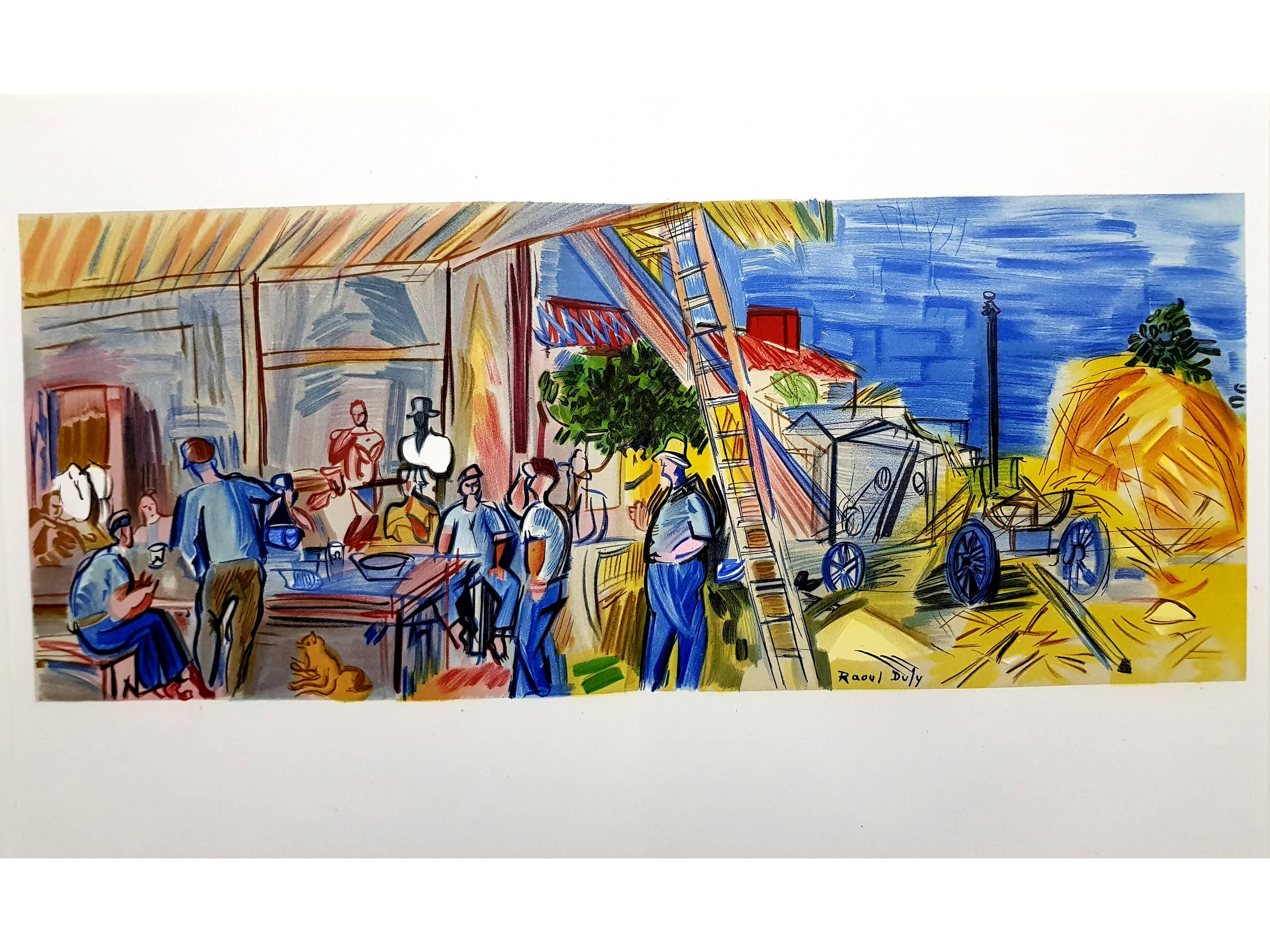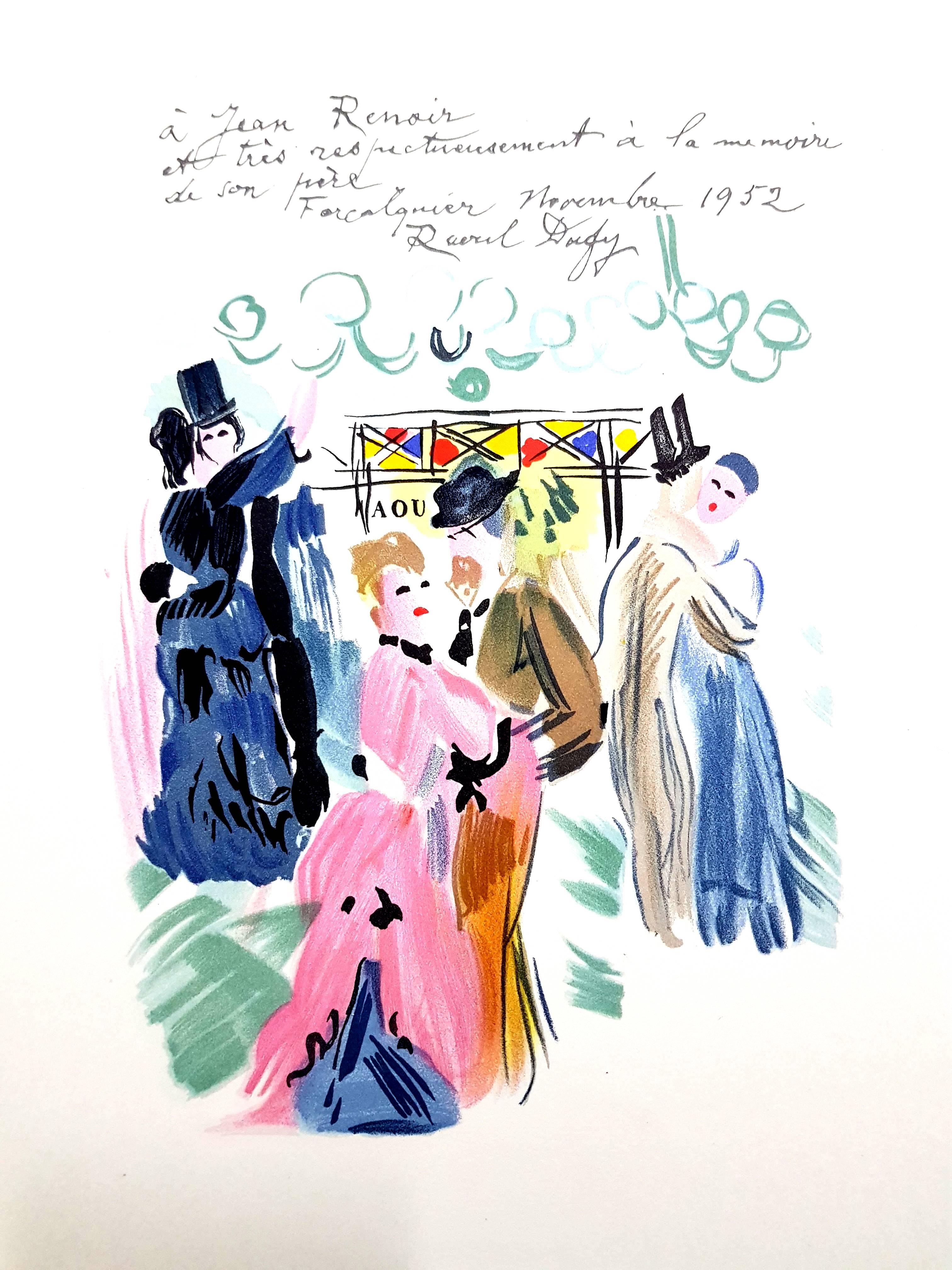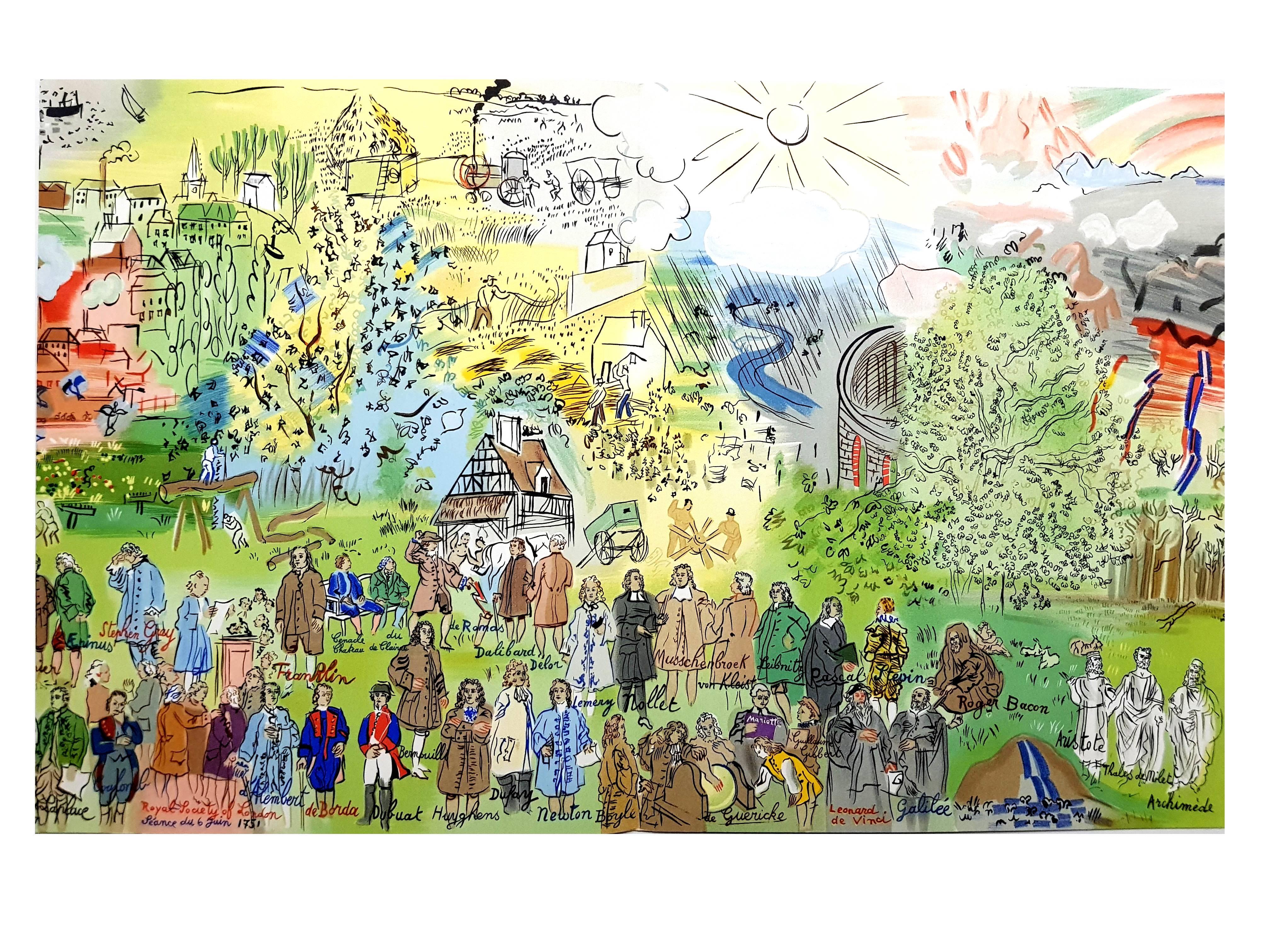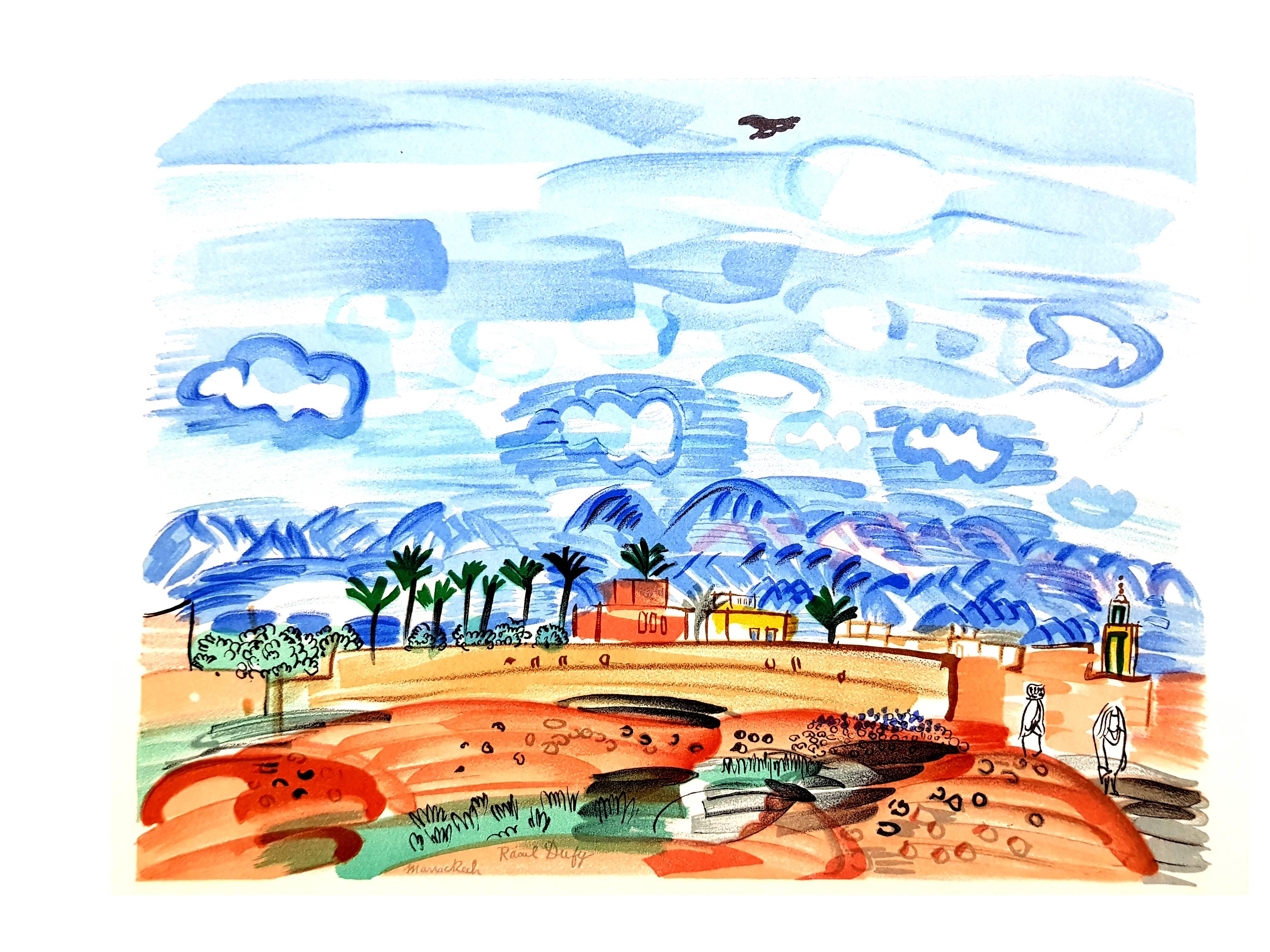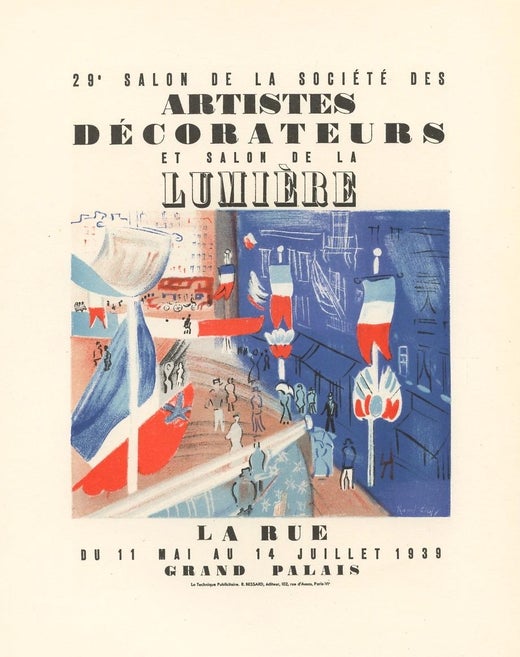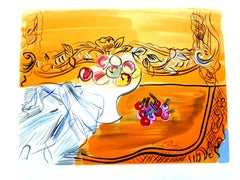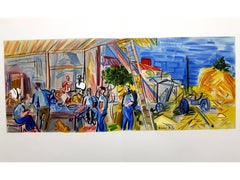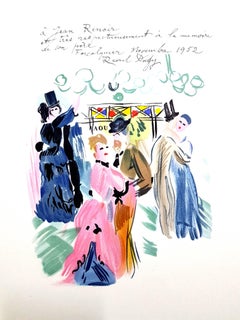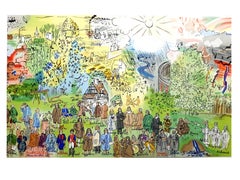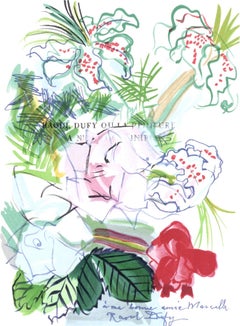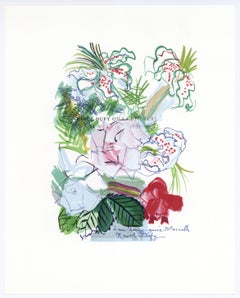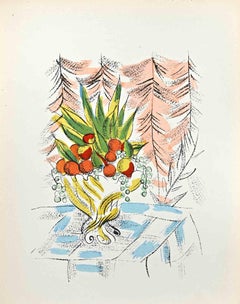Items Similar to Composition - Lithograph
Want more images or videos?
Request additional images or videos from the seller
1 of 9
(after) Raoul DufyComposition - Lithograph1965
1965
$1,425.59
£1,069.45
€1,200
CA$1,973.83
A$2,145.22
CHF 1,149.64
MX$26,046.73
NOK 14,433.03
SEK 13,384.44
DKK 9,141.77
About the Item
(after) Raoul Dufy
Lithograph after a watercolor, published in the book "Lettre à mon peintre Raoul Dufy." Paris, Librairie Académique Perrin, 1965.
Printed signature
Dimensions: 30 x 24 cm
Condition : Excellent
Raoul Dufy
Born in 1877, the French painter Raoul Dufy was one of the more controversial contributors to the Fauvism movement. Dufy’s paintings are a celebration of luxury and color, a style that helped Dufy carve his niche in the artistic landscape.
PERSONAL LIFE
Raoul Dufy was born in Le Havre in 1877. He was part of a very large family, and finances were somewhat difficult in the family. Dufy was lucky to be born during a vibrant time in the French art community. As a young man, he studied at the Ecole Municipale des Beaux-Arts du Havre. During his studies, Dufy became friends with fellow artist Othon Friesz. He rented a studio with Friesz at one point. In 1911, Dufy married Eugenie Brisson. He struggled with arthritis for much of his life, relying on cortisone treatments to allow him to continue painting.
CAREER
In 1900, Dufy received a scholarship that allowed him to go to Paris. While attending the Ecole des Beaux-Arts, Dufy was inspired by the many different art movements that were coalescing in France at the time. He experimented with many different styles during his artistic career. In 1903, Dufy first exhibited his work at the prestigious Salon des Independents. During this time, his art showed the influence of the Impressionists. His oil painting, Carnival on the Grands Boulevards, is one example of this early Impressionist work. By 1905, however, Dufy was drawing most of his inspiration from the creative, daring Fauvists. He also experimented with Cubism, working with Georges Braque. The variety of styles began to merge into Dufy’s unique vision as an artist. Completed in 1910, Mer et Nuages shows Dufy’s bold, playful use of bright colors. It also illustrates Dufy’s fondness for portraying beautiful and luxurious scenes, particularly French seaside tableaus. Throughout the 1920s and 1930s, Dufy developed a style that blended crisp, calligraphic lines with generous splashes of color. Le Chateau et la Grille and Le Retour des Ragates illustrate elements of this style. Painting was not Dufy’s sole interest. He was extremely far-ranging in his talents. Dufy created woodcut engravings to illustrate books. Later, he worked with the renowned designer Paul Poiret to create patterned fabrics. Dufy even designed theater sets and scenery. Although some critics found Dufy’s work too effervescent and not serious enough, the painter gained a reputation for his bright, versatile body of work.
- Creator:(after) Raoul Dufy (1877, French)
- Creation Year:1965
- Dimensions:Height: 11.82 in (30 cm)Width: 9.45 in (24 cm)Depth: 0.04 in (1 mm)
- Medium:
- Movement & Style:
- Period:
- Condition:
- Gallery Location:Collonge Bellerive, Geneve, CH
- Reference Number:1stDibs: LU16122293003
(after) Raoul Dufy
Raoul Dufy (1877 – 1953) was a French Fauvist painter, brother of Jean Dufy. He developed a colorful, decorative style that became fashionable for designs of ceramics and textiles, as well as decorative schemes for public buildings. He is noted for scenes of open-air social events. He was also a draftsman, printmaker, book illustrator, scenic designer, a designer of furniture, and a planner of public spaces. The impressionist landscape painters, such as Claude Monet and Camille Pissarro, influenced Dufy profoundly. Matisse's Luxe, Calme et Volupte, which Dufy saw at the Salon des Independants in 1905, was a revelation to the young artist, and it directed his interests towards Fauvism. Les Fauves (the wild beasts) emphasized bright color and bold contours in their work. Dufy's painting reflected this aesthetic until about 1909, when contact with the work of Cezanne led him to adopt a subtler technique. It was not until 1920, however, after he had flirted briefly with yet another style, cubism, that Dufy developed his own distinctive approach. It involved skeletal structures, arranged with foreshortened perspective, and the use of thin washes of color applied quickly, in a manner that came to be known as stenographic. Dufy's cheerful oils and watercolors depict events of the time period, including yachting scenes, sparkling views of the French Riviera, chic parties, and musical events.
About the Seller
4.9
Gold Seller
Premium sellers maintaining a 4.3+ rating and 24-hour response times
Established in 2015
1stDibs seller since 2015
970 sales on 1stDibs
Typical response time: 1 hour
- ShippingRetrieving quote...Shipping from: Collonge Bellerive, Geneve, Switzerland
- Return Policy
More From This Seller
View AllStill Life - Lithograph
By (after) Raoul Dufy
Located in Collonge Bellerive, Geneve, CH
(after) Raoul Dufy
Lithograph after a watercolor, published in the book "Lettre à mon peintre Raoul Dufy." Paris, Librairie Académique Perrin, 1965.
Printed signature
Di...
Category
1940s Fauvist Animal Prints
Materials
Lithograph
Raoul Dufy (after) - Autoportrait - Lithograph
By Raoul Dufy
Located in Collonge Bellerive, Geneve, CH
(after) Raoul Dufy
Lithograph after a watercolor, published in the book "Lettre à mon peintre Raoul Dufy." Paris, Librairie Académique Perrin, 1965.
Printed signature
Dimensions: ...
Category
1940s Fauvist Animal Prints
Materials
Lithograph
Homage to Renoir - Lithograph
By (after) Raoul Dufy
Located in Collonge Bellerive, Geneve, CH
(after) Raoul Dufy
Lithograph after a watercolor, published in the book "Lettre à mon peintre Raoul Dufy." Paris, Librairie Académique Perrin, 1965.
Printed signature
Dimensions: ...
Category
1940s Fauvist Animal Prints
Materials
Lithograph
Modernity - Lithograph - After Raoul Dufy
By (after) Raoul Dufy
Located in Collonge Bellerive, Geneve, CH
(after) Raoul Dufy
Lithograph after a watercolor, published in the book "Lettre à mon peintre Raoul Dufy." Paris, Librairie Académique Perrin, 1965.
Printed signature
Dimensions: ...
Category
1940s Fauvist Animal Prints
Materials
Lithograph
Raoul Dufy (after) - Landscape - Lithograph
By Raoul Dufy
Located in Collonge Bellerive, Geneve, CH
(after) Raoul Dufy
Lithograph after a watercolor, published in the book "Lettre à mon peintre Raoul Dufy." Paris, Librairie Académique Perrin, 1965.
Printed signature
Dimensions: ...
Category
1940s Fauvist Animal Prints
Materials
Lithograph
Charles Lapicque (after) - Homage to Dufy - Lithograph
By Charles Lapicque
Located in Collonge Bellerive, Geneve, CH
(after) Charles Lapicque
Lithograph after a watercolor, published in the book "Lettre à mon peintre Raoul Dufy." Paris, Librairie Académique Perrin, 1965.
Printed signatu...
Category
1940s Fauvist Animal Prints
Materials
Lithograph
You May Also Like
Raoul Dufy, Painted Flowers, from Letter to My Painter Raoul Dufy, 1965 (after)
By Raoul Dufy
Located in Southampton, NY
This exquisite lithograph after Raoul Dufy (1877–1953), titled Fleurs peintes (Painted Flowers), from the folio Lettre a mon peintre Raoul Dufy (Letter to My Painter Raoul Dufy), ori...
Category
1960s Fauvist Still-life Prints
Materials
Lithograph
$716 Sale Price
20% Off
Free Shipping
"Fleurs peintes" lithograph
By (after) Raoul Dufy
Located in Henderson, NV
Medium: lithograph (after the watercolor). This lithograph was printed on Arjomari wove paper by Mourlot Frères and published in 1965 for Marcelle Oury's "Lettre à mon peintre". Imag...
Category
1960s Prints and Multiples
Materials
Lithograph
Still Life - Lithograph by Raoul Dufy - 1920
By Raoul Dufy
Located in Roma, IT
Still Life is a lithograph realized by Raoul Dufy in 1920.
Good conditions.
Edition of 110.
The artwork is depicted through confident strokes in a well-balanced composition.
Category
1920s Modern Figurative Prints
Materials
Lithograph
Bunch of Flowers - Original Lithograph
By Raoul Dufy
Located in Paris, IDF
Raoul DUFY
Bunch of Flowers, 1953
Original Lithograph with stencil watercolor
With printed signature in the plate
On Arches vellum
28 x 37.5 cm (c. 11 x 14.8 inch)
Very good condition
Category
1950s Modern Still-life Prints
Materials
Lithograph
Projet de Tissus - Fauvist Flowers Watercolor & Gouache by Raoul Dufy
By Raoul Dufy
Located in Marlow, Buckinghamshire
Botanical watercolour and gouache on paper circa 1920 by French fauvist painter Raoul Dufy. The work depicts flowers in red, blue and green. This work was executed by Dufy as a fabric design.
Dimensions:
Framed: 19.5"x19.5"
Unframed: 12"x12"
Provenance:
Private collection of works by Raoul Dufy for Bianchini Ferier
Bianchini Ferrier Collection - Christie's London - July 2001
SF Fall Show
Raoul Dufy was one of a family of nine children, including five sisters and a younger brother, Jean Dufy, also destined to become a painter. Their father was an accountant in the employ of a major company in Le Havre. The Dufy family was musically gifted: his father was an organist, as was his brother Léon, and his youngest brother Gaston was an accomplished flautist who later worked as a music critic in Paris. Raoul Dufy's studies were interrupted at the age of 14, when he had to contribute to the family income. He took a job with an importer of Brazilian coffee, but still found time from 1892 to attend evening courses in drawing and composition at the local college of fine arts under Charles Marie Lhullier, former teacher of Othon Friesz and Georges Braque. He spent his free time in museums, admiring the paintings of Eugène Boudin in Le Havre and The Justice of Trajan in Rouen. A municipal scholarship enabled him to leave for Paris in 1900, where he lodged initially with Othon Friesz. He was accepted by the École des Beaux-Arts, where he studied under Léon Bonnat, whose innate conservatism prompted Dufy to remark later that it was 'good to be at the Beaux-Arts providing one knew one could leave'.
And leave he did, four years later, embarking with friends and fellow students on the rounds of the major Paris galleries - Ambroise Vollard, Durand-Ruel, Eugène Blot and Berheim-Jeune. For Dufy and his contemporaries, Impressionism represented a rejection of sterile academism in favour of the open-air canvases of Manet, the light and bright colours of the Impressionists, and, beyond them, the daringly innovative work of Gauguin and Van Gogh, Seurat, Cézanne, Toulouse-Lautrec and others. Dufy was an out-and-out individualist, however, and was not tempted to imitate any of these artists. He produced, between 1935 and 1937, Fée Electricité (Spirit of Electricity), the emblem for the French utilities company Electricité de France (EDF).
Dufy visited the USA for the first time in 1937, as a member of the Carnegie Prize jury. In 1940, the outbreak of war (and his increasingly rheumatic condition) persuaded him to settle in Nice. When he eventually returned to Paris 10 years later, his rheumatism had become so debilitating that he immediately left for Boston to follow a course of pioneering anti-cortisone treatment. He continued working, however, spending time first in Harvard and then in New York City before moving to the drier climate of Tucson, Arizona. The cortisone treatment was by and large unsuccessful, although he did recover the use of his fingers. He returned to Paris in 1951 and decided to settle in Forcalquier, where the climate was more clement. Within a short time, however, he was wheelchair-bound. He died in Forcalquier in March 1953 and was buried in Cimiez.
Between 1895 and 1898, Raoul Dufy painted watercolours of landscapes near his native Le Havre and around Honfleur and Falaise. By the turn of the century, however, he was already painting certain subjects that were to become hallmarks of his work - flag-decked Parisian cityscapes, Normandy beaches teeming with visitors, regattas and the like, including one of his better-known early works, Landing Stage at Ste-Adresse. By 1905-1906 Friesz, Braque, Matisse, Derain, Vlaminck, Van Dongen and Rouault were described collectively as Fauves (the wild beasts). What they had in common was a desire to innovate, but they felt constrained nonetheless to meet formally to set out the guiding principles of what promised to be a new 'movement'. Dufy quickly established that those principles were acceptable; moreover, he was most impressed by one particular painting by Henri Matisse ( Luxury, Calm and Voluptuousness) which, to Dufy, embodied both novelty and a sense of artistic freedom. Dufy promptly aligned himself with the Fauves. Together with Albert Marquet in particular, he spent his time travelling the Normandy coast and painting views similar...
Category
1920s Fauvist Still-life Drawings and Watercolors
Materials
Paper, Watercolor, Gouache
Fleurs et Papillons - Fauvist Flowers Watercolor & Gouache by Raoul Dufy
By Raoul Dufy
Located in Marlow, Buckinghamshire
Botanical watercolour and gouache on paper circa 1920 by French fauvist painter Raoul Dufy. The work depicts flowers in red and butterflies in blues, yellows, black and white. This work was executed by Dufy as a fabric design.
Dimensions:
Framed: 17"x27"
Unframed: 10"x20"
Provenance:
Private collection of works by Raoul Dufy for Bianchini Ferier
Bianchini Ferrier Collection - Christie's London - July 2001
SF Fall Show
Raoul Dufy was one of a family of nine children, including five sisters and a younger brother, Jean Dufy, also destined to become a painter. Their father was an accountant in the employ of a major company in Le Havre. The Dufy family was musically gifted: his father was an organist, as was his brother Léon, and his youngest brother Gaston was an accomplished flautist who later worked as a music critic in Paris. Raoul Dufy's studies were interrupted at the age of 14, when he had to contribute to the family income. He took a job with an importer of Brazilian coffee, but still found time from 1892 to attend evening courses in drawing and composition at the local college of fine arts under Charles Marie Lhullier, former teacher of Othon Friesz and Georges Braque. He spent his free time in museums, admiring the paintings of Eugène Boudin in Le Havre and The Justice of Trajan in Rouen. A municipal scholarship enabled him to leave for Paris in 1900, where he lodged initially with Othon Friesz. He was accepted by the École des Beaux-Arts, where he studied under Léon Bonnat, whose innate conservatism prompted Dufy to remark later that it was 'good to be at the Beaux-Arts providing one knew one could leave'.
And leave he did, four years later, embarking with friends and fellow students on the rounds of the major Paris galleries - Ambroise Vollard, Durand-Ruel, Eugène Blot and Berheim-Jeune. For Dufy and his contemporaries, Impressionism represented a rejection of sterile academism in favour of the open-air canvases of Manet, the light and bright colours of the Impressionists, and, beyond them, the daringly innovative work of Gauguin and Van Gogh, Seurat, Cézanne, Toulouse-Lautrec and others. Dufy was an out-and-out individualist, however, and was not tempted to imitate any of these artists. He produced, between 1935 and 1937, Fée Electricité (Spirit of Electricity), the emblem for the French utilities company Electricité de France (EDF).
Dufy visited the USA for the first time in 1937, as a member of the Carnegie Prize jury. In 1940, the outbreak of war (and his increasingly rheumatic condition) persuaded him to settle in Nice. When he eventually returned to Paris 10 years later, his rheumatism had become so debilitating that he immediately left for Boston to follow a course of pioneering anti-cortisone treatment. He continued working, however, spending time first in Harvard and then in New York City before moving to the drier climate of Tucson, Arizona. The cortisone treatment was by and large unsuccessful, although he did recover the use of his fingers. He returned to Paris in 1951 and decided to settle in Forcalquier, where the climate was more clement. Within a short time, however, he was wheelchair-bound. He died in Forcalquier in March 1953 and was buried in Cimiez.
Between 1895 and 1898, Raoul Dufy painted watercolours of landscapes near his native Le Havre and around Honfleur and Falaise. By the turn of the century, however, he was already painting certain subjects that were to become hallmarks of his work - flag-decked Parisian cityscapes, Normandy beaches teeming with visitors, regattas and the like, including one of his better-known early works, Landing Stage at Ste-Adresse. By 1905-1906 Friesz, Braque, Matisse, Derain, Vlaminck, Van Dongen and Rouault were described collectively as Fauves (the wild beasts). What they had in common was a desire to innovate, but they felt constrained nonetheless to meet formally to set out the guiding principles of what promised to be a new 'movement'. Dufy quickly established that those principles were acceptable; moreover, he was most impressed by one particular painting by Henri Matisse ( Luxury, Calm and Voluptuousness) which, to Dufy, embodied both novelty and a sense of artistic freedom. Dufy promptly aligned himself with the Fauves. Together with Albert Marquet in particular, he spent his time travelling the Normandy coast and painting views similar...
Category
1920s Fauvist Still-life Drawings and Watercolors
Materials
Paper, Watercolor, Gouache
More Ways To Browse
Raoul Dufy Watercolour
Pagliacci Aldo
Picasso Cape Print
Picasso Dog
Raphael Lillywhite
Signed Reuven Rubin Original Lithograph
Space Chair George Rodrigue
Susumu Kamijo
Vintage Beagle Prints
Vintage Fox Hunt Print
Will Barnet Cat
Andy Warhol Endangered Species
Audubon Eagle
Audubon Heron
Bill Alexander
Conrad Schwiering
Dali Rhinoceros
Dang Lebadang
